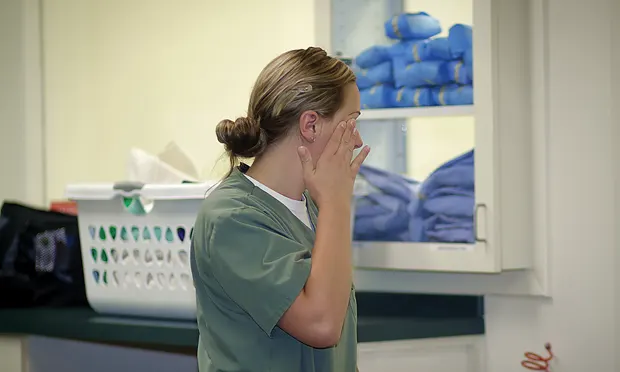Bullying and Aggression in the Veterinary Profession
Justine A. Lee, DVM, DACVECC, DABT, VETgirl, LLC

Having worked in busy emergency rooms and ICUs, I know how stressed and frazzled people can become when dealing with life-or-death decisions. This isn't an excuse for rudeness, yelling, screaming, bossing, and basic bad behavior. And don't forget about passive aggressiveness, manipulation, gossipmongering, backstabbing, creating cliques, exclusion...the list goes on.
Destructive behavior of this type, which is a complex combination of relational aggression, horizontal violence, or bullying, appears to be prevalent in the medical field.1,2 Relational aggression is a type of aggression designed to harm someone's social standing or relationships through manipulative behavior or by covert bullying.2 Horizontal violence is defined as untoward, unkind, offensive interactions directed toward one's peers or people of the same hierarchy.1,3 Finally, bullying is defined as any type of repetitive verbal or physical abuse that involves some type of power imbalance.4
Related Article: Am I the Toxic Team Member?
Although few veterinary studies can be found, many have looked at these problems in the human medical field. Consider these statistics5:
88% of nurses and other clinical-care providers have a teammate who gossips or is part of a clique that divides the team.
55% have a teammate who tries to look good at other's expense.
77% have coworkers who are condescending, insulting, or rude.
33% work with verbally abusive team members who yell, shout, swear, or name call.
52% work with people who abuse their authority—pull rank, bully, threaten, or force their own point of view.
I saw a lot of relational aggression during my internship and residency. I chalked it up to being a rite of passage, when it was actually nothing short of bullying, and now I'm ashamed that I was a passive observer who put up with so much and didn't speak up more. I should have called the bullies out and addressed the issue, but I honestly feared the repercussions (eg, not getting assistance when needed, getting all my treatments done last, not being liked). I've observed emergency technicians intentionally ignore interns' requests and do their treatments last because they didn't like the newbies. I've witnessed residents bully veterinary students, snapping rudely and giving them only trivial tasks.
However, as I grew in my career and matured as an individual, I became less tolerant of any kind of bullying and spoke up more. Why? Because I've been there (from cage cleaner to veterinary assistant to veterinary student to intern to resident), and I know how miserable it can be.
Related Article: Coworkers Who Drive You Crazy
So, what do we do about this kind of behavior? We recognize it. We don't tolerate it. We support each other and we stand up against it.
Provide strong leadership
Supervisors are the first line of defense when it comes to stopping bullying and they—whether veterinarians, veterinary technicians, or practice managers—must have strong communication skills while being firm, empathetic, trustworthy leaders. Managers and leaders should never tolerate bullying behavior and should always promptly nip it in the bud and appropriately address it. They should never respond to complaints of bullying with you'll get used to it or deal with it. They must address negative and destructive behaviors immediately or they will significantly damage the health of the entire team.
Be proactive about team member concerns. Check in frequently before the problem grows; address the inkling of a problem before it becomes an eruption, before the relationship is broken. It's imperative that practice leaders remain approachable so that every team member feels comfortable communicating his or her concerns.
Related Article: Is a Sexual Harassment Suit Possible in Your Practice?
What goes around, comes around
The veterinary community is small, making it important to play nicely together. I worked with a bitter, angry technician who made team members cry, yet leadership failed to address her until almost 10 years later, despite the complaints. Then, she had difficulty obtaining another job (and her rsum eventually came across my desk).
Implement behavioral interview techniques that can help identify warning signs of bullies before hiring.
Avoid hiring the bully
Implement behavioral interview techniques that can help identify warning signs of bullies before hiring. Do your research—when checking references, consult with others in the practice, such as the veterinarian, a junior team member, and a receptionist when appropriate.
More importantly, prevent problems from getting traction by performing annual evaluations in a timely manner. Prioritize teamwork and level of professionalism as performance criteria. Always perform some type of 360 evaluation in which every team member evaluates every other members performance to ensure accountability at multiple levels.
So what now?
In veterinary medicine, we must realize that relational aggression, horizontal violence, and bullying are prevalent in our profession and stop them in their tracks. We also need to consider that veterinary medicine is approaching a majority-female field, and we don't want to risk veterinary professionals being labeled catty. We wouldn't tolerate bad behavior from a dog. We certainly wouldn't reward bad behavior. Let's take it to our two-legged colleagues and stop bullying in its tracks.